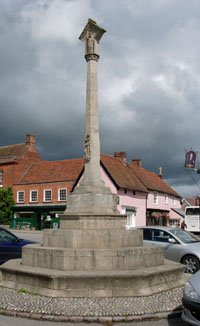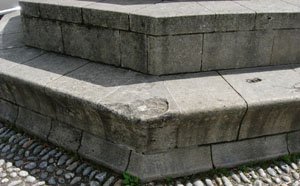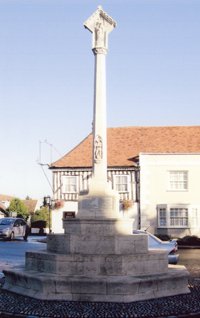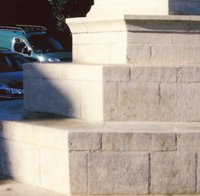Showcase result
Dedham Cross
Town or City: Colchester
County: Essex
Country: England
WMT Reference Number: WM1926
Value of grant: £1925.00
Type of memorial: Freestanding
Type of work: Conservation and repair
Grant scheme: Small Grants Scheme
Year: 2007
UKNIWM reference number: 22361
 The war memorial in the village of Dedham, Essex is Grade II listed. It is made of coarse grained limestone and has a four stepped base surmounted by a plinth and a tall shaft topped by an unusual stone crucifix. The crucifix, carved from a solid piece of stone, is almost the shape of an arrow head, with two parallel sides and then a “roof” with sloping sides. On one side of the stone is carved a representation of Jesus on the cross, and on the other Mary and the child Jesus.
The war memorial in the village of Dedham, Essex is Grade II listed. It is made of coarse grained limestone and has a four stepped base surmounted by a plinth and a tall shaft topped by an unusual stone crucifix. The crucifix, carved from a solid piece of stone, is almost the shape of an arrow head, with two parallel sides and then a “roof” with sloping sides. On one side of the stone is carved a representation of Jesus on the cross, and on the other Mary and the child Jesus.
In December 2007 War Memorials Trust gave a grant of £1925.00 towards work to clean the memorial and apply biocide to inhibit the growth of moss and lichen on the memorial; to replace some pointing; apply a shelter coat; and to fashion shallow stone indentations on the horizontal faces of steps of the memorial, to emphasise its use as a seating place.
In 2016 a further grant of £1,560 was awarded through War Memorials Trust Grant Scheme towards conservation and repair works. The memorial was cleaned using a steam-cleaning method and stone repairs and re-pointing were carried out using lime mortar.
Inscriptions are on the sides of the plinth in black lettering. On the north face of the plinth is the inscription
In honour of Dedham men
who died in the service of
their country and in the
cause of freedom
1914 – 1918 & 1939 – 1945
Below this, on the face of the highest step, is the inscription
We that survive perchance may end our days
In some employment meriting no praise
They have outlived this fea & their brave ends
Will ever be an honour to their friends
and above it, carved into the shaft, is a relief of St. George standing over a vanquished dragon.
 On the east and west faces of the memorial are the names of those who died in the First World War; on the south faces are the names of those who died in the Second, including two civilians. Carved into the south face of the shaft is a representation of a shepherd with a crook and lambs.
On the east and west faces of the memorial are the names of those who died in the First World War; on the south faces are the names of those who died in the Second, including two civilians. Carved into the south face of the shaft is a representation of a shepherd with a crook and lambs.
The memorial was designed in the style of a market cross by Mr. W.D. Caroe, was built in 1919 and dedicated in 1921. It is situated in the centre of the village of Dedham, and was designed so that the lower steps could be used as seating.
Turning to those commemorated, men who fell at several of the major battle of the First World War are represented on the memorial, as well as those who served in less well known theatres.
The defence of Givenchy in France was an early example of the tactics that are perhaps associated with the First World War, and which caused so many casualties; bombardment of enemy positions followed by frontal assaults. The purpose of the action at Givenchy, which took place in December 1914, was to continue to harass the Germans, in order to prevent them reinforcing their troops fighting the French at Arras. Even though the tactics had previously caused heavy casualties they were not changed. In addition, being winter, the conditions were very difficult; many of the soldiers that died during this battle were victims of frostbite and exposure. Pte. Rout of the 2nd Battalion Grenadier Guards died on 26th December 1914. The website 1914-1918.net tells us that “The burial of many bodies of comrades lying in the frost and bloody pools of no man's land was one of the motivations for the Christmas fraternisation that soon occurred in this area.”
 Lives were lost in a similar way at the battle of Loos in the autumn of 1915; British artillery bombardment had failed to break through the German wire in many places so British soldiers were advancing over open fields in full range of German machine guns and artillery. In preparation for the attack the British released chlorine gas - the first time in the war they had done so - but some of it floated back over the British lines and killed British soldiers. Pte. Alfred Rudge of Dedham died in September 1915 during the battle of Loos. His younger brother Bertie would die eighteen months later during a battle to push the Germans back to the Hindenburg Line.
Lives were lost in a similar way at the battle of Loos in the autumn of 1915; British artillery bombardment had failed to break through the German wire in many places so British soldiers were advancing over open fields in full range of German machine guns and artillery. In preparation for the attack the British released chlorine gas - the first time in the war they had done so - but some of it floated back over the British lines and killed British soldiers. Pte. Alfred Rudge of Dedham died in September 1915 during the battle of Loos. His younger brother Bertie would die eighteen months later during a battle to push the Germans back to the Hindenburg Line.
Two of the members of the Essex Regiment commemorated on the memorial, Sgt. Ogg and Pte. Double, died during the Gallipoli campaign. Pte. Finbow, also of the Essex Regiment, returned from Gallipoli, but died on the third day of the Battle of the Somme, one of five men on the memorial to die at the Somme. There is evidence that four of these five died of their wounds in hospital rather than being killed on the battlefield.
A number of the soldiers on the memorial were regular soldiers. Pte Sage was in the 1st Battalion Bedfordshire Regiment, one of the regiments of “Old Contemptibles” who held up the progress of the German army at the beginning of the war. He died during a subsidiary action of the Battle of Arras in April 1917. Pte. Radford, another member of the regular army, died during the Arras offensive two months later in a flanking operation.
In the spring of 1918 the Germans launched a new offensive. 2nd Lieutenant Barnard died at the end of March during the opening battle of the German offensive, and Pte. Byles in mid September.
Although the Western Front is the best known of the theatres of war between 1914 and 1918, Allied troops also fought in the south eastern Europe and the eastern Mediterranean. Pte. Grimsey was a member of the Royal Inniskilling Fusiliers. After the withdrawl from Gallipoli his division was sent to Salonika and took part in the action at Kosturino in Macedonia in December 1915. In late summer 1917 they moved to Egypt and were thereafter involved in the Palestine campaign, where Pte. Grimsey died in May 1918. He is buried in Jerusalem.
 The men commemorated from the Second World War have a variety of stories too; that of Pte. Henry Polson, along with those of six men with whom he died, has been turned into a book, “The Greater Share of Honour”. The book was inspired by a mistake on a memorial giving the wrong date of their deaths (the men died in June 1940). You can find more information at the link below.
The men commemorated from the Second World War have a variety of stories too; that of Pte. Henry Polson, along with those of six men with whom he died, has been turned into a book, “The Greater Share of Honour”. The book was inspired by a mistake on a memorial giving the wrong date of their deaths (the men died in June 1940). You can find more information at the link below.
Trooper Eagle belonged to the Royal Tank Regiment. The RTR served during the Fall of France in May 1940, taking part in the action at Arras on 21st May 1940 in which Rommel's 7th Panzer Division was attacked, and Rommel nearly killed. Trooper Eagle was killed during the Dunkirk evacuation, and the cemetery in which he is buried contains only two Commonwealth war graves, so is perhaps just a small French churchyard.
After the evacuation from Dunkirk the Allies had no foothold on mainland Europe. In November 1940 Allied troops landed in Crete, an important strategic location in the eastern Mediterranean. However, the Germans, after overrunning Greece, took Crete in May 1941, the first airbourne invasion in history. Pte. Howe was killed at the end of May; it seems likely that he was on a ship that was hit as it was carrying evacuating service personnel from Heraklion to Alexandria.
The focus in the Mediterranean then turned to North Africa. After battles where the two sides gained and lost the same territory several times, the Allies had a breakthrough at El Alamein in the autumn of 1942. Lance Sarjeant Garrod of 5th Battalion Grenadier Guards was killed in Tunisia in March 1943. In May 1943, the war in North Africa came to an end in Tunisia with the defeat of the Axis powers by a combined Allied force.
With the war won in North Africa the Allies then invaded Italy, giving them a presence on the European mainland. Lieutenant Dalton of the 1st Punjab Regiment died in July 1944 during the time that the Germans were making their first attempts to stop the Allied advance north of Rome.
Some of the men on the Dedham memorial went even further away than North Africa. Sarjeant Edward Bland served with the Nigeria Regiment of the Royal West African Frontier Force and is commemorated on a memorial in Freetown, Sierra Leone. Pte. John Bland is buried at Thanbyuzayat War Cemetery in Burma, a graveyard for those who died while building the Burma Railway, indicating that he must have been taken a prisoner of war by the Japanese. There is no indication of whether these two men were related.
Most of the people found on memorials are battle casualties, but not exclusively. Pte. Francis of the Essex Regiment was possibly a prisoner when he died in Czechoslovakia, as there is as another member of his battalion who has a similar story. The 2/5th Essex regiment fought the Battle of Deir-el- Shein. Stanley Neville, of that regiment but not of Dedham, was captured along with many others, and was held in POW camps in Italy. He tried several unsuccessful attempts to escape and was eventually transferred to what is now the Czech Republic. On Christmas Day 1944, the Americans bombed the factory where Stanley was being forced to work. Stanley lies in a cemetery in Prague, as does Pte. Francis, who had died in July 1944. Two of the names on the memorial are those of civilians; Joan Coomber and her six week old son Robert died on 10th December 1943. There are not many details available about this terrible event but one can only imagine that it was caused by an enemy bomb.
This, then is some background of those who are commemorated at Dedham. Thanks to the work of the Parish Council and the grant from WMT, the memorial will continue to be a practical feature of the village, and the names of those who died will not be forgotten.
Further information
War Memorials Trust reference WM1926
UK National Inventory of War Memorials: 22361
The Bedfordshire Regiment in the First World War
For more on the Battle of Crete click here or here
British and Commonwealth Orders of Battle
A man who has a story similar to Leonard Francis
Database of information about the British Army in the First World War, including information on orders of battle and timelines.
If you have a concern about this memorial please contact the Trust on conservation@warmemorials.org


